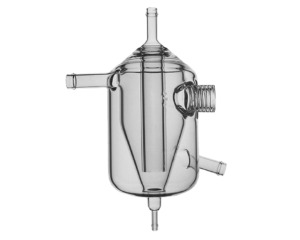ICP-OES Spray Chamber Maintenance with an Ultrasonic Cleaner

Inductively Coupled Plasma Optical Emission Spectrometers are costly and require regular maintenance to assure accurate performance. An ultrasonic cleaner is recommended for ICP-OES spray chambers and we share here two approaches, one employed by a user and the other recommended by a distributor. Labs using this equipment should above all follow the recommendations of their supplier but can look to Tovatech for ultrasonic cleaning equipment that meets these recommendations.
Ultrasonic Cleaning ICP-OES Spray Chambers
An ultrasonic cleaner is recommended because spray chambers have complex shapes making it difficult to remove contaminants that deposit during ICP-OES operation. Cleaning is provided by cavitation action, or the implosion of minute bubbles in an ultrasonic cleaning solution, on all chamber surfaces while immersed in the solution. This action is produced by generator-powered ultrasonic transducers bonded to the bottom of a stainless steel tank. It quickly and safely blasts away trace elements and organic contaminants deposited during ICP-OES operation.
Selecting an Ultrasonic Cleaning Solution
We found two widely different ultrasonic cleaning solution formulations used for cleaning ICP-OES spray chambers. In the case of the user of the equipment a highly acidic 2% nitric acid solution is used in a 2.5 gallon Elma S100H ultrasonic cleaner provided by Tovatech.
In this instance the stainless steel ultrasonic cleaner tank must be protected by an acid-resistant plastic tub insert sized for the ultrasonic cleaner being used. The procedure is to pour plain water along with a surfactant into the tank. This is followed by carefully inserting the plastic tub containing the acidic cleaning solution. The bottom of the plastic tub must be in contact with the water but must not contact the bottom of the cleaning tank. Cavitation energy passes through the water and the tub bottom to clean the spray chambers immersed in the acid solution. The ultrasonic cleaner timer is set for 10 minutes, after which the spray chambers are removed and inspected. If cleaning is complete they are allowed to dry before being replaced in the ICP-OES. Otherwise the ultrasonic cleaning process should be repeated.
Remember when using acidic solutions to have an air handling system that draws off fumes.
Cleaning steps recommended by the distributor follow much the same procedure except that a neutral aqueous surfactant is used for 5 to 15 minutes depending on the condition of the spray chamber. At the end of the ultrasonic cleaning cycle components are removed and rinsed before reassembly. In this case no special precautions need be taken to protect the ultrasonic cleaner or personnel from acid fumes.
Which Ultrasonic Cleaning Procedure to Use?
Whatever cleaning formulation you use it must be degassed prior to the cleaning operation. If your cleaner does not have a degas function simply operate it without a load until air bubbles stop rising to the surface. Otherwise the cleaning process is prolonged.
And as suggested above, ICP-OES manufacturers rule when it comes to maintaining their equipment and cleaning spray chambers. But you can rely on the ultrasonic cleaning professionals at Tovatech for unbiased recommendations on specifying ultrasonic cleaners and solutions that mesh with the manufacturers’ recommendations.